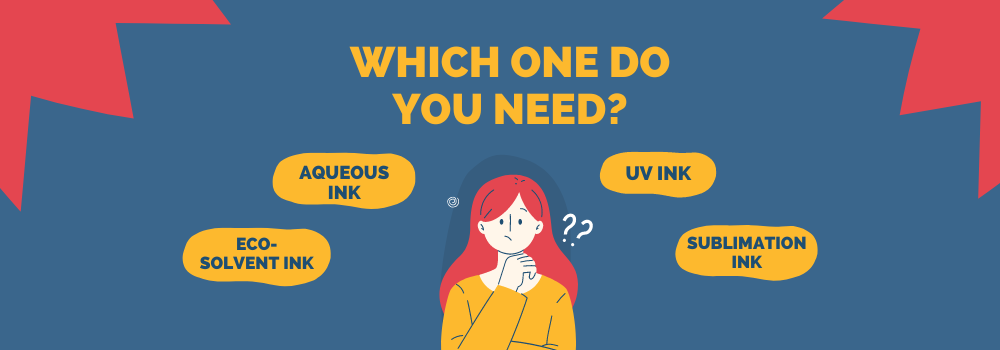

When facing numerous ink choices in the printing industry, selecting the right ink is crucial for printing quality, cost control, and environmental impact. This article will compare the features of Eco-Solvent, Aqueous, Traditional Solvent, UV, and Sublimation Inks to help you make the best choice for your needs.
Eco-Solvent Ink is a type of ink that uses low volatile organic compounds (VOCs), making it suitable for both indoor and outdoor use.
| Key Features of Eco-Solvent Ink: | |
| Eco-friendliness | With lower VOC content, it has a smaller environmental impact. |
| Durability | It offers moderate drying speed and excellent UV, water, and scratch resistance, especially for outdoor applications. |
| Application | Ideal for advertising prints, vehicle wraps, and indoor and outdoor signage. |
Aqueous Ink primarily uses water as a solvent, making it one of the most eco-friendly inks, especially in environmentally sensitive settings.
| Key Features of Aqueous Ink: | |
| Eco-friendliness | As it uses water as the primary solvent, it produces no VOC emissions and is suitable for environmentally conscious applications. |
| Durability | It requires longer drying time and may not be suitable for applications needing high water and light resistance. |
| Application | Ideal for paper printing, labels, and art reproduction. |
Traditional Solvent Ink remains a popular choice for high-speed printing due to its fast drying and durable properties.
| Key Features of Traditional Solvent Ink: | |
| Eco-friendliness | High VOC emissions can negatively impact the environment, requiring vapor recovery systems. |
| Durability | Dries quickly, making it suitable for high-speed printing. |
| Durability | Offers excellent outdoor durability and scratch resistance. |
| Application | Ideal for large-scale outdoor advertisements and signage in demanding environments. |
UV Ink cures instantly under UV light, offering excellent adhesion on various substrates and fast drying speeds.
| Key Features of UV Ink: | |
| Eco-friendliness | No solvent evaporation during the curing process, but UV lamps are required. |
| Durability | Instant curing upon UV exposure, with no drying time needed. |
| Application | Suitable for a wide range of substrates (glass, plastic, wood), perfect for advertising, industrial, and packaging printing. |
Sublimation Ink is primarily used for printing on textiles and personalized products. It works by transferring the image onto the target surface through heat, commonly used for T-shirt printing, ceramics, metals, and other materials.
| Key Features of Sublimation Ink: | |
| Personalization | Ideal for small-batch personalized products. |
| Image Clarity | Produces high-quality, clear images, great for photo prints. |
| Durability | Images do not fade easily over time, ensuring longevity. |
| Application | Best for long-lasting, custom-printed items like apparel and promotional goods. |
Choosing the right ink depends on your specific printing needs. If you prioritize eco-friendliness and indoor use, Aqueous Ink is likely the best choice. For durability and outdoor printing, Eco-Solvent Ink has the edge. UV Ink is ideal for printing on a wide range of materials with fast drying times, while Sublimation Ink excels in producing small-batch custom products.
CHROMOINK offers a comprehensive range of Eco-Solvent, Aqueous, UV, and other specialized inks that meet environmental regulations and cater to various applications. Whether you’re printing advertisements, packaging, or personalized products, our inks provide the best solutions for your printing needs.